Ijraset Journal For Research in Applied Science and Engineering Technology
- Home / Ijraset
- On This Page
- Abstract
- Introduction
- Conclusion
- References
- Copyright
Campus Connect: An Online Learning Platform
Authors: Shubham Nandkishor Deore, Dhammadeep Gaikwad, Yash Joshi, Suhas Chougule, Mr. Ramesh Shahabade
DOI Link: https://doi.org/10.22214/ijraset.2023.55544
Certificate: View Certificate
Abstract
Through this project, we aim to solve the problem that has arisen due to the pandemic - how can traditional methods of learning be integrated with e-learning? We are driven to create an application that seamlessly merges the two methods that the education system currently relies on, allowing both students and teachers to benefit. Students using this app will be able to access their attendance records, course status, test performances, and online study resources. Teachers will be provided with an interface through which they can upload attendance records, provide recorded lectures or notes, and interact with students to solve their doubts. They can also communicate with parents to address any concerns they may have regarding their child. Additionally, teachers will be allowed to share notices on the app, which will notify students and allow them to schedule tests. Parents using this application can track their ward\'s performance.
Introduction
I. INTRODUCTION
The COVID-19 pandemic has led to a paradigm shift in the way we perceive education. In order to prevent the spread of the virus, most educational institutions have been compelled to shift to online mode. This has given rise to a chaotic and hectic situation where teachers not only have to manage teaching but also update their curriculum plans and notify students and parents via their respective class WhatsApp groups. Though these tasks are manageable, an efficient way to handle them is necessary.
We recognized this problem and decided to develop a platform that would provide an efficient way to handle the challenges that have arisen due to the pandemic. We are working on creating a hybrid learning platform that is designed to cater to the needs of students, parents, and teachers. The platform would provide seamless integration between traditional methods of learning and e-learning, so that both students and teachers can benefit from it.
This platform is an android application that has been designed to be user-friendly and accessible to all. The interface has been designed keeping in mind that the intended users would be teachers, students, and parents. The platform would provide an interface to teachers to upload attendance, circulars, notes, and schedule tests. Students would be able to view their attendance records, course status, test performances, and access online study resources. Parents would be able to view their child's progress reports, attendance records, and get notified about upcoming events.
Our team is dedicated to making this application efficient and easy to use for everyone. We understand that the pandemic has caused immense stress and uncertainty, and we believe that our platform can provide much-needed relief to students, parents, and teachers. Our platform is designed to simplify the education system by providing a single platform for students, parents, and teachers to communicate, access resources, and stay updated.
The administrator will be responsible for keeping track of the database and ensuring that the application is running smoothly. We believe that our hybrid learning platform can make a significant difference in the lives of students, parents, and teachers, and we are committed to delivering a high-quality product that meets their needs. Our platform aims to bridge the gap between traditional learning methods and e-learning, providing a comprehensive solution to the challenges that have arisen due to the pandemic.
II. LITERATURE SUREVEY
Brika SKM, Chergui K, Algamdi A, Musa AA and Zouaghi R [1] in this paper E-Learning Research Trends in Higher Education in Light of COVID-19: A Bibliometric Analysis The study used bibliometric analysis to track e-learning trends in higher education during the COVID-19 pandemic. The research focused mainly on pedagogical techniques, particularly e-learning and collaborative learning, but acknowledged that other trends are developing in this area as well.
Piyush Joshi, Dr. Shweta Dewangan [2] Impact And Development of Online Education (E- Learning) In India The importance of e-learning and web-based learning has become more apparent during the COVID-19 pandemic. E-learning portals offer flexibility and a range of tools to enhance the learning experience. However, there are still challenges to the widespread adoption of e-learning, including connectivity issues and resistance to change from traditional methods of learning. While e-learning has significant potential for improving education, addressing these challenges will be crucial to its success.
Hassan Abuhassna1, Waleed Mugahed Al-Rahmi, Noraffandy Yahya, Megat Aman Zahiri Megat Zakaria, Azlina Bt. Mohd Kosnin and Mohamad Darwish [3] Development of a new model on utilizing online learning platforms to improve students' academic achievements and satisfaction. This research discusses and explains the potential contribution that it may have to the field of online learning platforms, as well as presenting insights into students' satisfaction and academic achievement. However, it is limited in scope to a specific geographical area, which may impact the generalizability of the findings to other contexts. Further research in other regions and contexts will be necessary to fully understand the impact of online learning platforms on student satisfaction and academic achievement.
Veeramanickam & Dr. M. Mohanapriya [4] Research paper on E-Learning application design features: Using cloud computing & software engineering approach proposes a well-defined module for teachers and students, presumably for use in education. However, it is noted that this module is only a web application, suggesting that it may have limitations in terms of functionality or accessibility compared to other forms of educational technology. Further information on the specific features and capabilities of the web application would be necessary to fully evaluate its potential usefulness for teachers and students.
III. METHODOLOGY
The goal of this project is to create a comprehensive application that merges an online learning platform with a student management system. The application must enable both faculties and students to view their attendance reports, which will be generated after they punch in their attendance using biometric technology. The platform should include sections for tracking course progress, examinations, circulars, and resources. Additionally, the application should be equipped with the ability to send in-app notifications. To facilitate seamless communication between teachers and students, the application should have a user-friendly interface. Faculties will be able to upload course materials, schedule tests, and post circulars, while students can access these resources and view their attendance reports. The application must also allow for biometric attendance recording, which will be a crucial feature for ensuring accurate attendance tracking. The course progress section of the application will help students keep track of their academic progress, including assignments, projects, and exams. The examination section will provide information about upcoming exams and allow students to view their grades once the exams are completed. In the circulars section, important announcements and updates can be posted for easy access by all users. The resources section of the application will provide students with access to study materials, including lecture notes, presentations, and video tutorials. This will be a valuable tool for students to review course content outside of class time. Additionally, the in-app notification system will allow for real-time communication between teachers and students, making it easier to share important updates and deadlines. This application will provide a streamlined platform for both faculties and students to manage their academic progress, access resources, and communicate with one another. The use of biometric attendance tracking will ensure that attendance records are accurate and up-to-date, and the user-friendly interface will make it easy for all users to navigate the application.
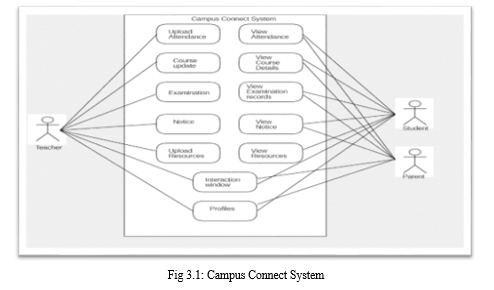
This part describes the whole architecture of the Campus Connect system. The architecture consists of Teacher, Student and Parents section.
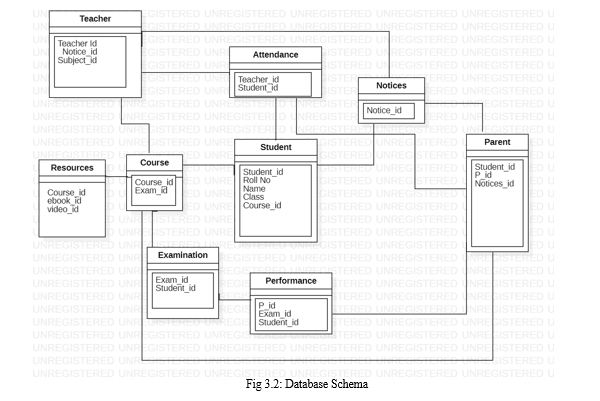
This part is the database schema for the Campus Connect System which defines the organization and format of the data.
A. Software Model
The model which is followed for designing this application is Iterative Model.
The iterative model is a popular approach to software development that involves breaking down the development process into small, iterative cycles. The model emphasizes continuous feedback and improvement, with each iteration building on the progress made in the previous one. unlike other software development models that require a complete specification of requirements before development begins, the iterative model starts with a simple implementation of a small set of software requirements. Once this initial version is complete, it is reviewed to identify further requirements and to gain feedback from stakeholders. Based on this feedback, the software is iteratively enhanced and refined until the complete system is implemented and ready to be deployed.
The iterative model is especially useful in situations where requirements are uncertain or subject to change. By breaking down the development process into small, manageable steps, it allows for more flexibility and adaptability in response to changing requirements or new information. It also enables stakeholders to provide feedback throughout the development process, which can help ensure that the final product meets their needs and expectations.
One of the key benefits of the iterative model is its ability to deliver a working product early in the development process. This can help to reduce the risks associated with software development by allowing stakeholders to test and provide feedback on the software at an early stage. Additionally, the iterative model promotes a collaborative and iterative approach to development, which can lead to greater creativity, innovation, and problem-solving.
This is the Iterative Model for the Campus Connect System.
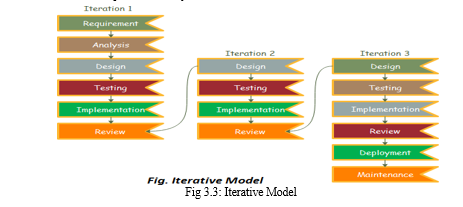
IV. PROPOSED WORK
- The main objective of this project is to create a hybrid learning platform application that seamlessly merges traditional methods of learning with e-learning.
- Biometric attendance integration is a crucial feature that will be incorporated into the application to ensure accurate attendance tracking for both students and faculty members.
- The application will have designated functionality for viewing attendance records, which will allow both students and faculty members to update them. In addition, parents will also be able to see their child's attendance record through the app.
- The application will provide users with the functionality to view their test results and see the schedule for upcoming tests.
- Notifications will be sent to users to notify them of any new notices or circulars that have been added to the application.
- The application will also include a feature that allows students to access E-notes and video resources, providing them with a wealth of study materials to enhance their learning experience.
V. RESULTS AND EXPERIMENTATION
The following are the implementation screenshots that demonstrate the step by step working of our application:
Upon installation of the app, the first screen that appears provides access to three separate login consoles for students, parents, and faculty members. Each console is designed to provide individualized functionality for its respective users. Overall, the login consoles provide a convenient and efficient way for users to access the app's features and functionality. By providing individualized consoles for students, parents, and faculty members, the app is able to meet the unique needs and requirements of each group
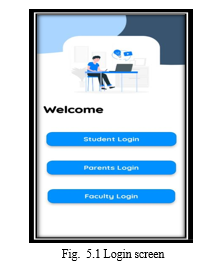
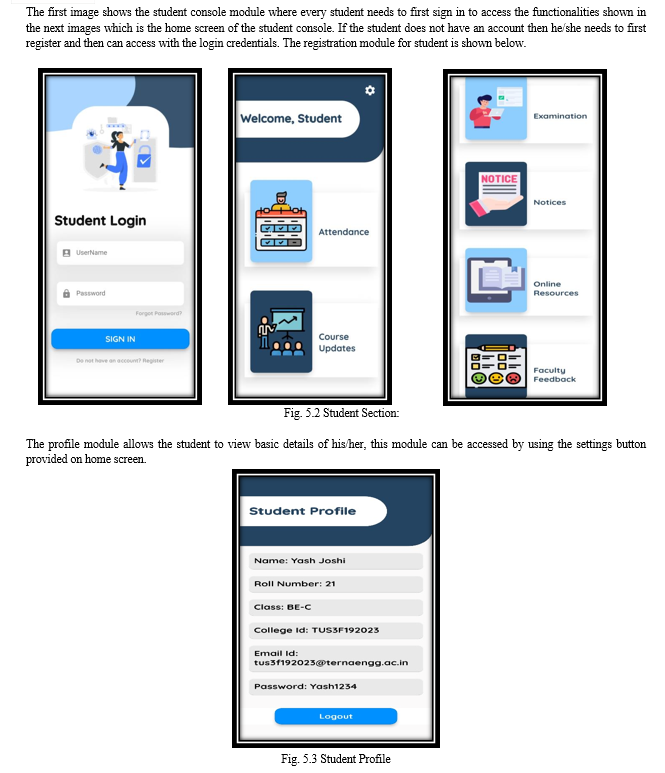
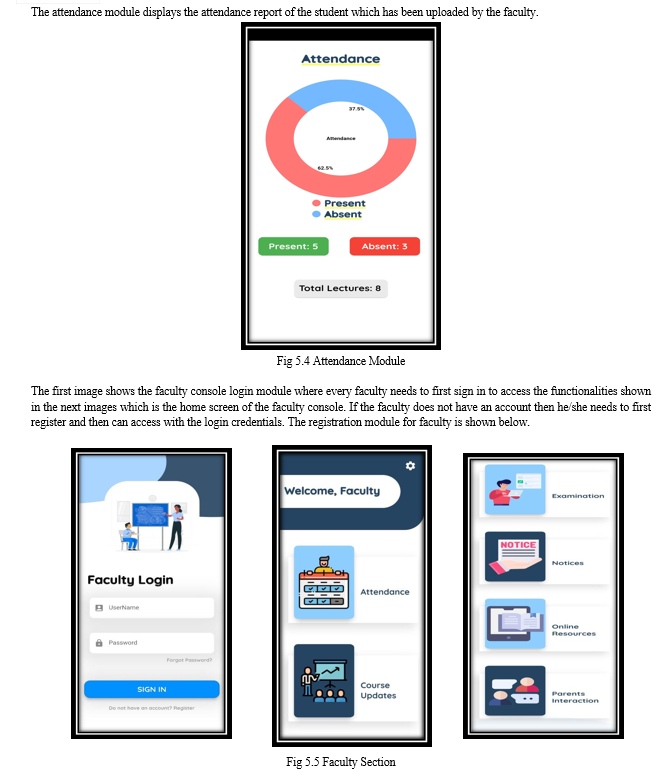
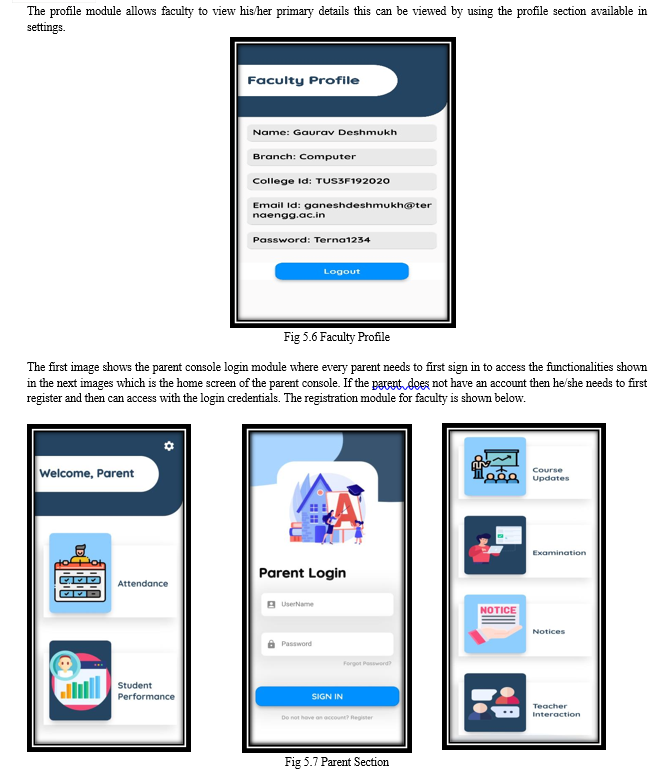
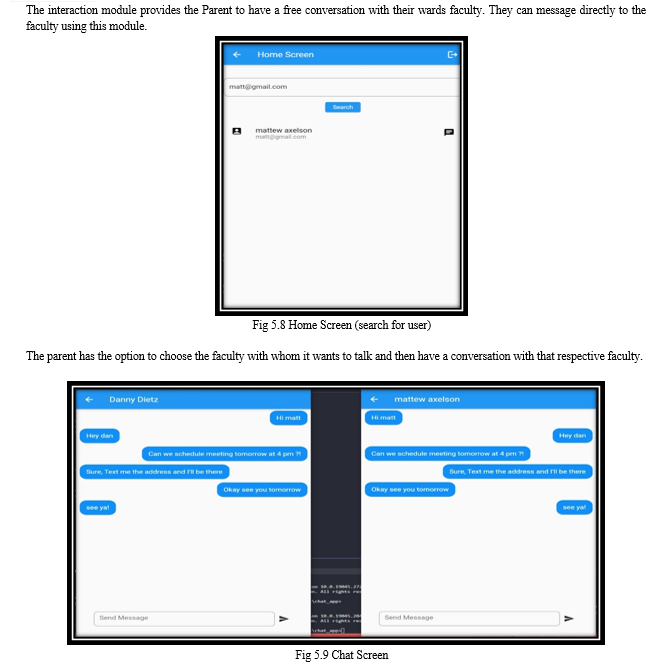
Conclusion
The development of the hybrid learning platform application has been a success, providing a comprehensive solution for educational institutions to manage their day-to-day operations in an efficient and effective way. The app has been designed with a user-friendly interface, ensuring that students, faculty, and parents can easily access the features and functionality provided by the application. The inclusion of biometric attendance integration has been a crucial feature, allowing for accurate tracking of attendance records for both students and faculty members. The designated functionality for viewing attendance records has been useful for all stakeholders, allowing for easy tracking and updating of records. the application has provided users with the functionality to view their test results and upcoming schedules, and has sent notifications to users to keep them informed of any new notices or circulars. The availability of E-notes and video resources has also enhanced the learning experience for students, providing them with a wealth of study materials to aid in their studies. We also followed the iterative model for development, allowing for continuous feedback and improvement throughout the development cycle. This has ensured that the final product meets the needs and requirements of the end-users.the creation of this android application has been a significant step towards efficient and effective management of educational institutions, and we believe that it will make a positive impact on the education industry.
References
[1] Brika SKM, Chergui K, Algamdi A, Musa AA and Zouaghi R (2022) E-Learning Research Trends in Higher Education in Light of COVID-19: A Bibliometric Analysis. Front. Psychol. 12:762819. doi: 10.3389 / fpsyg. 2021.762819 [2] Joshi & Dr. Shweta Dewangan Impact And Development Of Online Education (ELearning) In India, Journal of Contemporary Issues in Business and Government Vol. 27, No. 1, 2021 [3]Hassan Abuhassna1, Waleed Mugahed Al-Rahmi, Noraffandy [3] Yahya, Megat Aman Zahiri Megat Zakaria, Azlina Bt. Mohd Kosnin and Mohamad Darwish,Development of a new model on utilizing online learning platforms to improve students’ academic achievements and satisfaction, Abuhassna et al. International Journal of Educational Technology in Higher Education (2020) [4] M.R.M Veeramanickam & Dr. M. Mohanapriya, Research paper on E-Learning Application Design Features using Cloud Computing & Software Engineering Approach, International Conference On Information Communication And Embedded System(ICICES 2016) [5] Shan Jin, Design of an Online Learning Platform with Moodle , The 7th International Conference on Computer Science & Education (ICCSE 2012) [6] Partha Pratim Ray Web based E-learning in India: the cumulative views of different aspects, ,Indian Journal of Computer Science and EngineeringVol. 1 No. 4 340-352,2010 [7] Marian Mihaescu, E-Learning Platform Used for Monitoring and Analyzing User Traffic, Serbia & Montenegro, Belgrade, 2005 [8] Ava Chikurteva, Nina Spasova, Denis Chikurtev E-learning: Technologies,application and challenges,Proc. XXIX International Scientific Conference Electronics (IEEE 2020) [9] Li Jianhong,Wu Xinyue Design of Mobile Learning Platform based on Android, The 15th International Conference on Computer Science and Education 2020 [10] A. Gunasekaran, Ronald D. McNeil , Denmis Shaul E-learning: research and applications, Industrial and Commercial Training Volume 34 2002 [11] Riah F. Elcullada Encarnacion, Annjeannette Alain D. Galang Impact and Effectivenes of E-learning on Teaching and Learning International Journal of Computing Sciences Research. [12] Kefas Rimammnusked Galadima, Munura Maihankali Bweseh, Benjamin Musa Implementation of Real Time E-LearningMobile Application in Tertiary Institutions, IOSR-JCE May-June 2021 [13] Bolanie Adefowoke Ojokah, Folasade Olubusola Isinkaye, Ohanide Sunday Adewale A Mobile Based Management System International Journal of Web based Learning and Teaching Technologies 2013 [14] Zima Mushtaq, Abdul Wahid Mobile Application Learning: The next generation e-learning, ICICT 2018 [15] Shivangi Viral Thakker, Jayesh Parab and Shubhankar Kaisare Systematic research of e-learning platforms for solving challenges faced by Indian engineering students, Asian Association of Open Universities Journal 2020.
Copyright
Copyright © 2023 Shubham Nandkishor Deore, Dhammadeep Gaikwad, Yash Joshi, Suhas Chougule, Mr. Ramesh Shahabade. This is an open access article distributed under the Creative Commons Attribution License, which permits unrestricted use, distribution, and reproduction in any medium, provided the original work is properly cited.

Download Paper
Paper Id : IJRASET55544
Publish Date : 2023-08-28
ISSN : 2321-9653
Publisher Name : IJRASET
DOI Link : Click Here
 Submit Paper Online
Submit Paper Online

